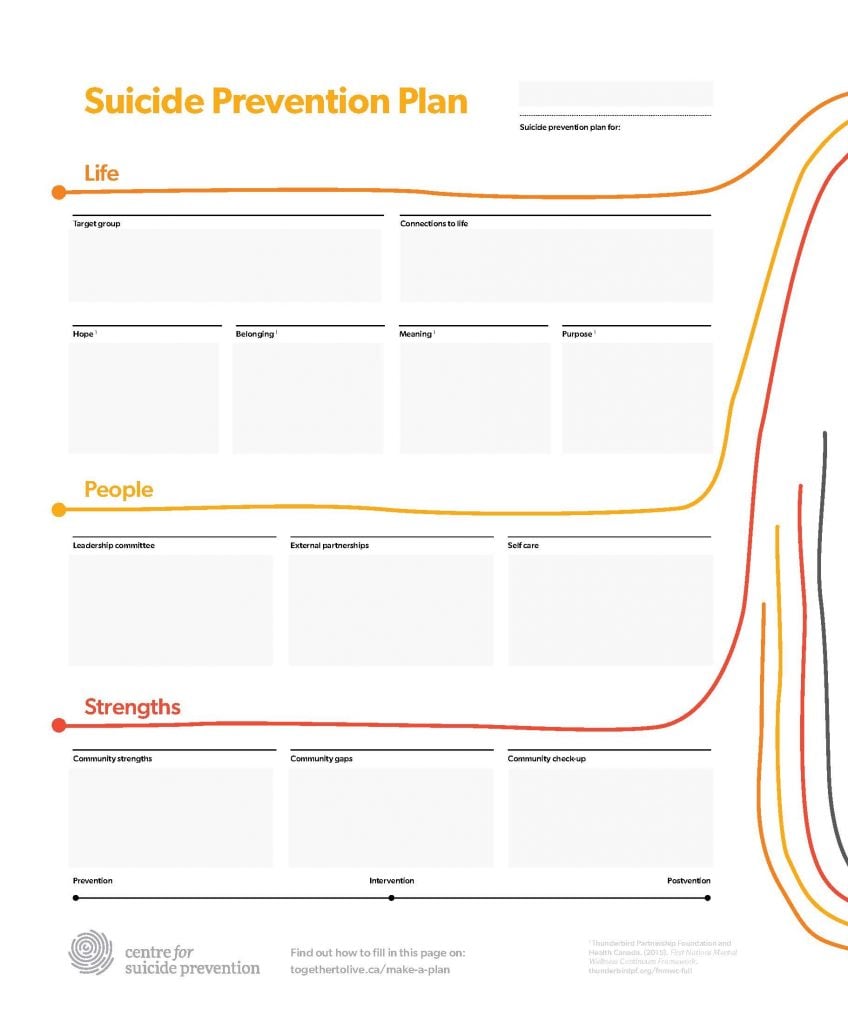Create a Plan

Introduction


Focusing in on activities
As a committee, reflect on the information you have obtained thus far. Consider involving some of your identified partners for this stage, too. You have identified what is currently happening and where there is room for growth, what your community values and what connects your target population to life.
Looking at the whole picture, what life promotion and suicide prevention activities do you want to focus on? Consider your strengths and gaps, and where your community may need balance along the PIP continuum in your community check-up.
Use the information you’ve gathered so far to do some brainstorming and answer the following questions with your committee:
- Do we want to focus on prevention, intervention, or postvention? (Goal)
- Which activities would we like to expand on as part of our Plan? (Activity)
- Which activities would we like to add? (Activity)
- Who can lead this activity? (Lead)
- When do we expect this activity to be completed? (End date)
- Who is being left out of this activity? (Activity)
- What is the estimated cost of this activity? (Activity)
Take some time to reflect upon who may be left out of the identified activities.
Try to connect what you already have in your community with what connects your target population to life. For example, if your target population finds belonging among friends and you have a gathering space in your community that is currently being underused, consider what could be done to help facilitate belonging. Using what you already have and what connects your community to life will ensure the plan’s sustainability – it’s easier to connect the dots than reinvent the wheel.
Identifying and addressing challenges
The planning you’re doing now will help ensure that implementation goes as smoothly as possible, however, it is likely that you will be faced with some difficulties when implementing the plan. Take some time as a committee to discuss what challenges could arise in implementation, and how these challenges could be addressed.
Evaluating your activities
As a committee, reflect on the information you have obtained thus far. Consider involving some of your identified partners for this stage, too. You have identified what is currently happening and where there is room for growth, what your community values and what connects your target population to life.
Looking at the whole picture, what life promotion and suicide prevention activities do you want to focus on? Consider your strengths and gaps, and where your community may need balance along the PIP continuum in your community check-up.
Evaluation can help you determine whether your activities are achieving what you hoped they would, and if there is something you would like to change. It’s helpful to develop the evaluation plan together with the actual Plan. As you establish Plan goals, think about how you will know if you’ve met them – what will success look like? A helpful evaluation will identify what is working (strengths), what is missing (gaps), and what may need to be modified (opportunities) for the next round. Evaluation helps direct our work.
Ask your committee (or even, community) the following questions:
- What would we like to see come from this activity? (What does success look like?)
- What is important for our community to measure or understand further?
- How will we know when we’ve achieved success?
Identifying what to measure will help determine what goes into your evaluation. Themes that go into a final report (to the community or to funders) may be extracted from this data.
Choose how you will measure outputs, outcomes and impacts before you begin your activities, and when possible start measuring as soon as you begin your activities. For example, if you choose to measure a change in behaviour, before your activity has even started, create pre and post surveys for your participants to fill out and have them ready for when the activity begins.
Evaluation measures
Outputs
- Tracks what you’re doing.
- How to do it: Count the volume/numbers of
Outcomes
- Tracks what happens as a result of what you’re doing (a change in behaviour).
- How to do it: Most commonly done by pre and post surveys, where participants indicate their behaviour before and after. Can also be done through storytelling or dialogue such as interviews, focus groups, or talking circles.
Process
- Tracks how you’re doing it.
- How to do it: Data can be gathered through administrative data, surveys, storytelling, and/or dialogue such as interviews, focus groups, or talking circles
We’ll discuss evaluation more in Step 5, however, evaluation is best started at the beginning of the work.
Creating a budget
After identifying your activities, enlist someone from the committee or community who is familiar with your finances to create a budget, if needed, for any of the activities you’ve selected.
Some activities may not require financial backing, but chances are many will. Take into consideration staffing as well as any other needed resourcing to make the activity happen or, in the case of existing activities, to scale up.
Perhaps you’ve identified some areas where the community is currently underspending its budget – can these resources be reallocated to the Plan activities?
Resource
Charity Village
Budgeting for nonprofits course
www.charityvillage.com
Securing funding
In reviewing the budget for your plan, you may find the need to ask for more resources.
This may involve presenting the plan with a cost-benefit analysis to the leaders in your community who provide funding, or it may involve applying for funding.
If you decide to apply for funding, have someone on your committee do a scan of what funding might be available for suicide prevention activities in your area. Once you’ve found a funder, they may provide a budget template according to their requirements.
As part of your scan for funding opportunities, contact:
- Municipal, provincial and federal governments
- Local charities (e.g. United Way, Rotary Clubs)
Funders for work specific to Indigenous communities and people can be found in the Community-led life promotion plans for Indigenous youth and communities guide.
Worksheet


